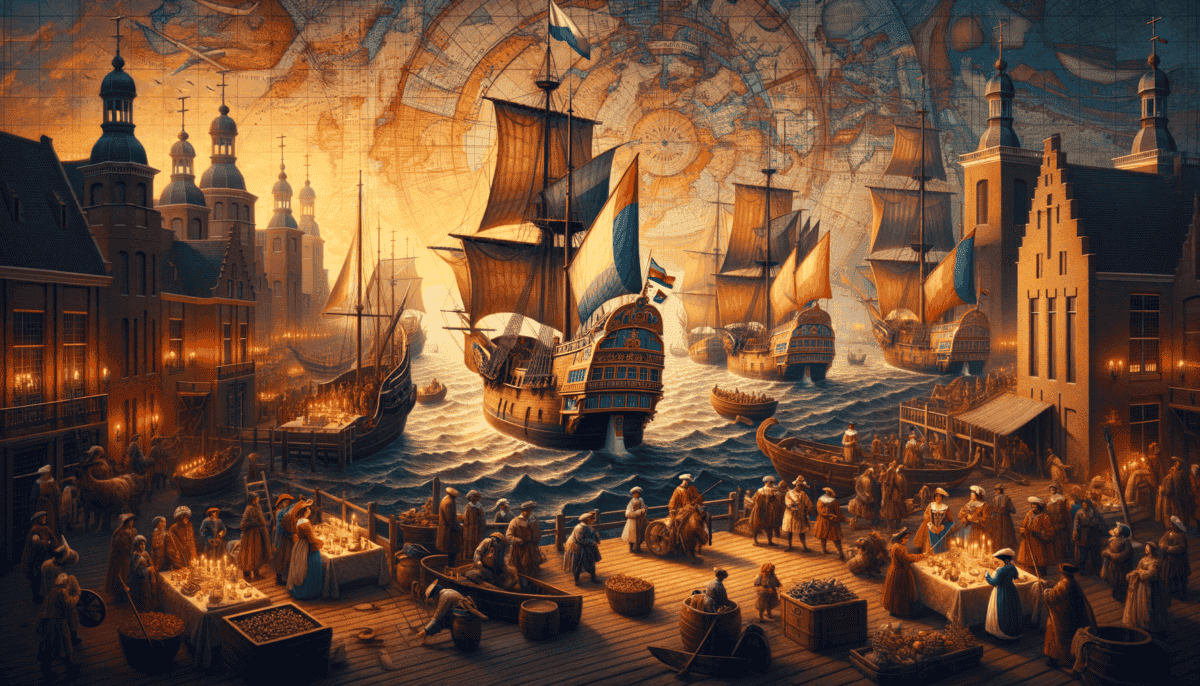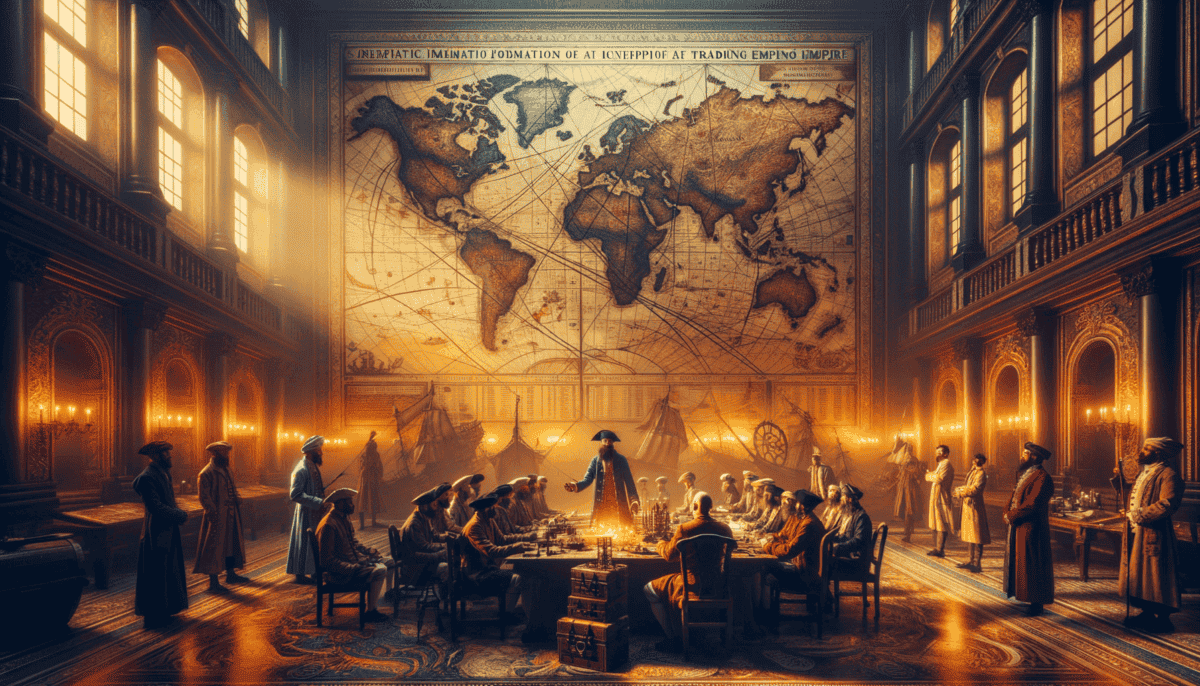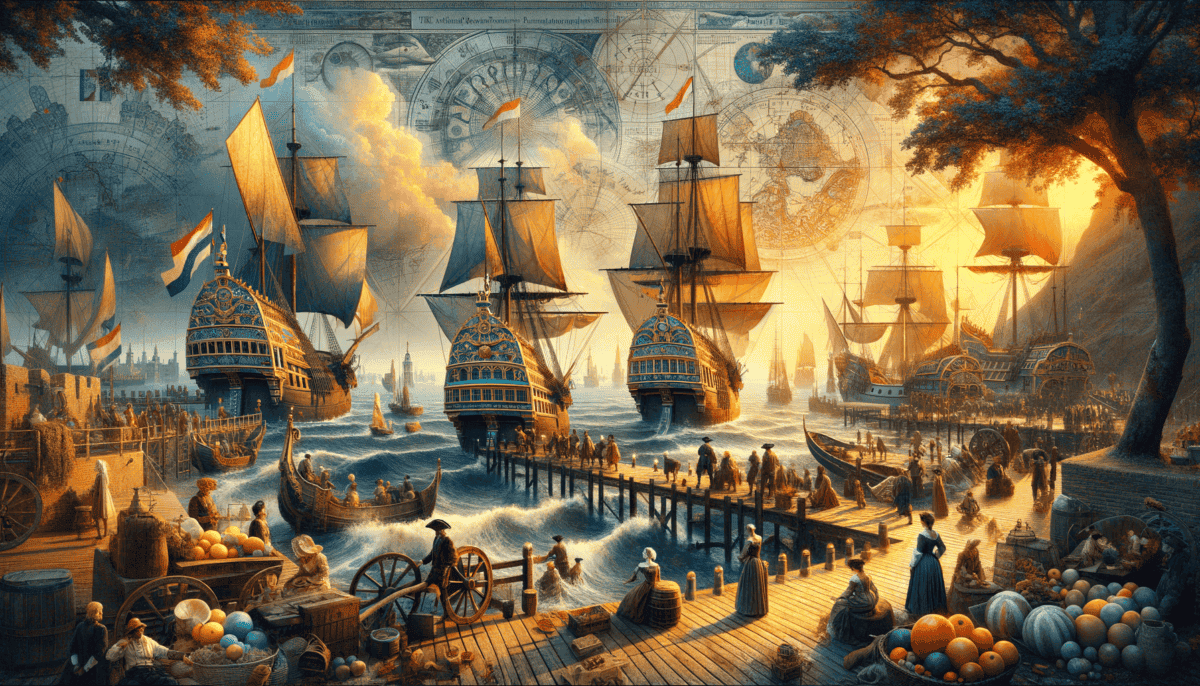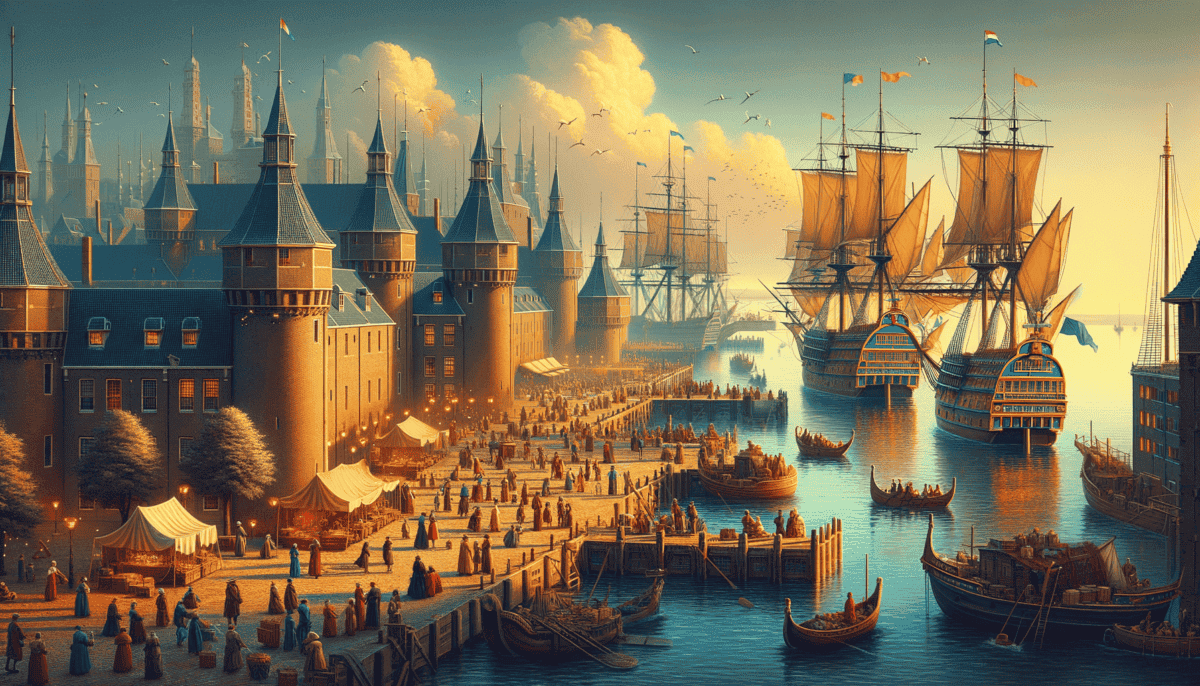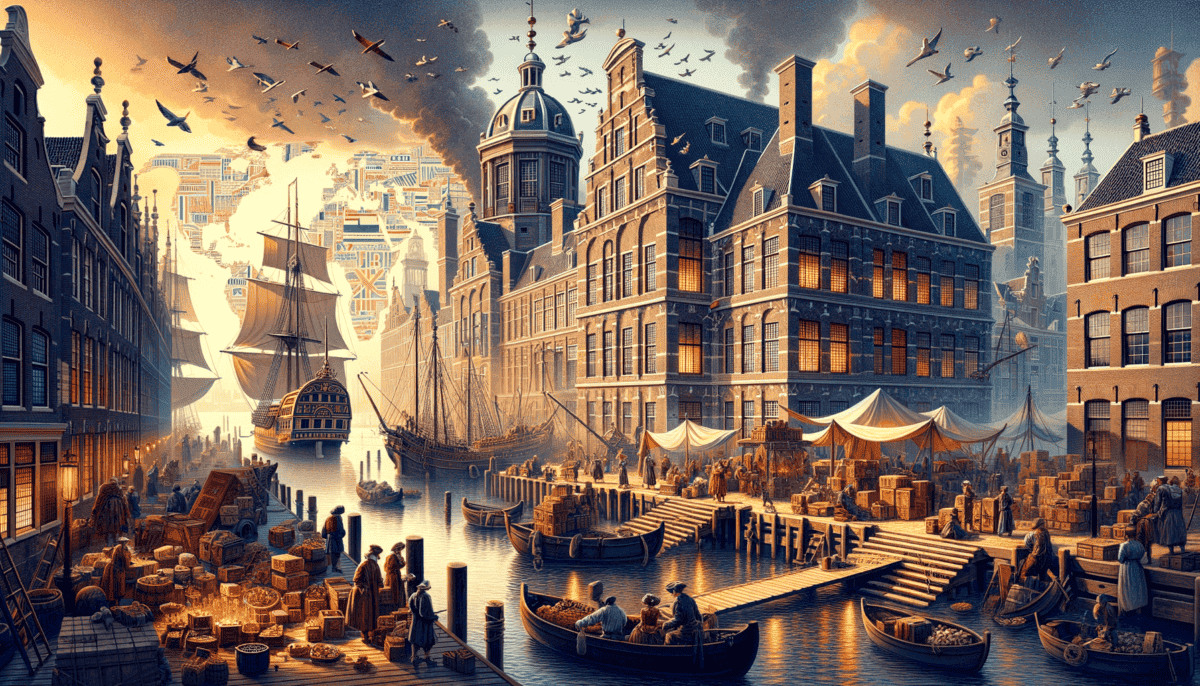A Small Country Dreams Big
Little Jan peered over the wooden dikes that kept the sea at bay. His home, the Netherlands, was a tiny place – so small you could walk across it in just a few days! But Jan knew his country had big dreams.
"Papa, why do we build these big walls?" Jan asked his father, who worked as a dike keeper.
"Without them, son, the sea would flood our lands. We Dutch people are clever – we learned to push back the water and make new land to live on!"
Jan loved watching the big ships sail past their town. Every day, more vessels would come and go from the busy harbor. Some were fishing boats bringing in fresh fish, while others were merchant ships carrying exciting goods from far away.
"Where do all these ships go, Papa?" Jan wondered aloud.
His father smiled. "They sail to places we can only dream about – lands where spices make your tongue tingle and silk feels softer than a cloud."
Smart Solutions for a Small Land
The Dutch people were very clever about using their small space. They built special windmills that could pump water away from flooded areas. These windmills became a symbol of Dutch creativity. ⚡
One day, Jan's teacher showed the class a new kind of map. It was different from the old ones – it showed better ways for ships to sail across the big oceans.
"Our map makers are the best in the world," the teacher said proudly. "Dutch sailors use these maps to find their way across the seas!"
Dreams Set Sail
As Jan grew older, he noticed more changes in his homeland. The Dutch were building better ships than anyone else. These ships could sail faster and carry more goods. They had special features that made them perfect for long journeys across dangerous seas.
"Soon," his father told him, "our ships will sail to every corner of the world. We may be a small country, Jan, but we have big plans!"
The harbors got busier and busier. More warehouses were built to store goods from far away. Dutch sailors became known as the best in the world. They weren't afraid to try new routes or sail into unknown waters.
One evening, as Jan watched the sunset over the harbor, he saw dozens of ships preparing for long voyages. Their sails caught the golden light, making them look magical.
"We're going to do great things," he whispered to himself. "Just watch and see!"
The air was filled with excitement. Everyone could feel that something big was about to happen. The little country by the sea was ready to show the world what it could do. The Dutch people had worked hard to protect their land from the water, and now they were ready to use that same determination to build something even bigger.
From their small corner of Europe, the Dutch were about to change the world. Their ships would soon sail to places no European had ever seen, carrying Dutch courage, cleverness, and dreams across the seas.
Jan looked at the setting sun one last time before heading home. Tomorrow would bring new ships, new adventures, and new chances for his small but mighty country to show what it could do.
Brave Hearts on Ocean Waves
The morning sun sparkled on the harbor waters as young Pieter watched the sailors load their ship. It was 1595, and Dutch ships were ready to sail farther than ever before.
“What’s in all those barrels?” Pieter asked Captain Willem, his uncle.
“Food and fresh water for our long journey,” Willem replied. “We’ll be at sea for many months!”
Into the Unknown
The sailors faced many challenges on their first big trips. Storms tossed their ships like toys. Hot sun made the deck so hot they couldn’t walk barefoot. Sometimes the wind stopped blowing, and they had to wait for days.
“How do you know where to go?” Pieter asked, watching his uncle check his maps.
“We follow the stars at night,” Willem explained. “And we use these new tools called compasses. But sometimes, we just have to be brave and sail into the unknown.”
Meeting New Friends
When Dutch ships reached new lands, they met people who looked and spoke differently. At first, everyone was nervous. But soon, they learned to trade using hand signals and simple words.
“Look what they gave us!” a sailor shouted, holding up colorful spices and silk cloth. “And they like our wool and metal tools!”
Some meetings were harder than others. Not everyone wanted to trade with strangers. Some local rulers were suspicious of the Dutch ships. But many were curious about these visitors from far away.
Making New Routes
The Dutch sailors drew careful maps of their journeys. They marked safe harbors where ships could stop for fresh water. They wrote down which winds could help them sail faster. ️
“Each trip teaches us something new,” Willem told Pieter. “We learn better ways to sail, safer routes to take, and how to make friends in new places.”
Growing Stronger
More and more Dutch ships sailed out to explore. They found routes to Asia, Africa, and the Americas. Each successful trip made the Netherlands stronger and richer.
The harbors got very busy. Ships brought back exotic goods:
• Spices from Indonesia
• Tea from China
• Sugar from the Caribbean
• Gold from Africa
• Silk from India
Back home, Pieter’s mother tried cooking with new spices. “These make our food taste amazing!” she exclaimed. “And look at this beautiful silk cloth!”
Dreams Come True
Years later, Pieter stood on his own ship’s deck, now a captain like his uncle. He watched new sailors learn to use maps and compasses. He smiled, remembering his first days watching ships in the harbor.
“We’ve come so far,” he thought. “But there’s still so much more to explore!”
The Dutch ships kept sailing, finding new routes and making new friends. Their little country was becoming famous all around the world. Every ship that sailed out carried Dutch courage and dreams across the seas.
Building a Trading Empire
In a cozy Amsterdam cafe in 1602, a group of merchants sipped hot tea and made a big decision. They would join together to create something new – the Dutch East India Company!
A Smart Plan
“If we work together, we can build bigger ships and sail to more places,” said Jan van Oldenbarnevelt, one of the leaders. The other merchants nodded in agreement.
Maria, a merchant’s daughter, watched with excitement. “Papa, will our ships go everywhere now?”
“Yes, dear,” her father smiled. “We’ll have ships sailing all the way to Asia and back!”
Getting Organized
The company was super organized. They built special offices in six Dutch cities. Each office had its own ships and workers. They made new rules about trading that everyone had to follow.
The company gave their captains special flags and papers. These showed that the ships belonged to the Dutch East India Company. Other countries learned to recognize these symbols.
• Special company flags
• Trading papers
• Maps and charts
• Money for trading
• Big warehouses
Racing Across the Seas
Other countries also wanted to trade in Asia. English, Portuguese, and Spanish ships raced against Dutch ships to get there first! ♂️
“Look!” shouted a sailor. “There’s an English ship ahead!”
“Quick!” the captain ordered. “Set more sails. We must reach the spice islands first!”
Making Trading Posts
The company built special trading posts in many places. These were like little Dutch towns in far-away lands. They had houses, offices, and big walls to keep everything safe.
In places like Indonesia, India, and South Africa, you could find these Dutch trading posts. Local people came there to trade their goods for Dutch products.
Growing Bigger
The company grew very big, very fast. They had hundreds of ships and thousands of workers. Their ships carried:
• Spices from Indonesia to Europe
• Chinese tea to Amsterdam
• Japanese copper to India
• Indian cotton to Africa
Changing the World
Maria grew up watching the company change her world. New foods appeared in markets. People wore clothes made from Asian silk. Dutch paintings showed scenes from far-away places.
“Our little country is doing big things,” Maria told her own children years later. “We’re connecting people all around the world through trade.”
The Dutch East India Company became the biggest trading company ever seen. Its ships sailed across all the oceans, carrying goods and ideas between different cultures. The tiny Netherlands was becoming a giant in world trade!
Treasures and Troubles at Sea
The sun rose over the spice-filled harbor of Batavia. Captain Willem stood on his ship’s deck, watching workers load precious cargo. The air smelled sweet with cinnamon and pepper.
Special Treasures
“What makes these spices so special?” asked Pieter, the captain’s young son.
“Ah,” Willem smiled, picking up a stick of cinnamon. “Back home in Amsterdam, people will pay lots of money for this. It makes their food taste amazing!”
• Black pepper from Sumatra
• Cinnamon from Ceylon
• Nutmeg from the Banda Islands
• Cloves from the Moluccas
• Fine silk from China
Dangerous Waters
Sailing wasn’t always easy. Dark clouds gathered on the horizon. “Storm coming!” shouted the lookout.
“Quick, tie down the spice boxes!” Willem ordered. “We can’t let our treasure get wet!”
The waves grew bigger. Lightning flashed across the sky. The sailors worked hard to keep the ship safe.
Meeting New Friends and Foes
In the busy port of Malacca, Dutch traders met people from many lands. Some became good friends. Others caused trouble.
“Look, Portuguese ships!” warned the lookout one day. “They want our trading spot!”
“Stay calm,” Willem told his crew. “We’ll try talking first. Fighting is bad for business.”
Making Deals
Local rulers often visited Dutch trading posts. They wore beautiful clothes and brought gifts.
“Welcome, Sultan!” Willem bowed. “Would you like to see our new Dutch cloth?”
The Sultan smiled. “Yes, and I have pepper to trade. Let’s make a deal!”
Changes at Home
Back in Amsterdam, people’s lives were changing. Market stalls sold new things from far away.
Sarah, a baker’s daughter, sniffed the air. “Mmm, what’s that smell?”
“Cinnamon from far away,” her mother said. “Want to try some in our bread?”
Growing Problems
Not everything was perfect. Some local people didn’t like Dutch trading posts in their lands. Ships sometimes got lost in storms. Other countries tried to steal Dutch cargo.
“We must be careful,” Willem told Pieter. “Trading is like a game. Sometimes you win, sometimes you lose. But always be fair.” ⚖️
Learning from Each Other
Dutch sailors learned new things from people they met. They tried new foods, heard new music, and saw new ways of living.
“Dad, look at these strange fruits!” Pieter pointed.
“Those are mangoes,” Willem explained. “Aren’t they delicious? We can take some home to share!”
As the sun set over the harbor, Willem watched his ship’s crew working together with local people. Dutch sailors spoke bits of local languages. Local traders used Dutch words. Together, they were building something new – a world where people from different places could work together and share good things.
The Golden Time of Dutch Success
The streets of Amsterdam were buzzing with excitement. Ships packed with treasures from far away filled the harbors. Artists painted beautiful pictures. Scientists made amazing discoveries. This was the Dutch Golden Age! ✨
A City Full of Wonders
“Look at all the new buildings!” Emma exclaimed to her father. Tall houses with fancy windows lined the canals.
“Our city is growing rich from trade,” her father smiled. “People come here from all over the world!”
• Beautiful new houses
• Big ships in the harbor
• Art galleries and museums
• Science labs and workshops
• Markets full of special foods
Smart Ideas and New Tools
Dutch people were very clever. They made better maps to help ships find their way. They built stronger ships that could sail farther.
“What’s that?” Emma pointed at a strange tube with glass pieces.
“That’s a telescope,” explained the scientist. “It helps us see things far away. Want to try?”
Art and Beauty
Artists like Rembrandt painted pictures that told stories. Their paintings showed ships, markets, and people from different lands.
“These paintings help us remember our adventures,” said the museum guide. “See the spice markets? The silk traders? The brave sailors?”
Learning and Growing
Schools taught children about math, science, and far-away places. Libraries had books from all over the world.
“Dad, can I learn to be a map maker?” Emma asked.
“Of course! Dutch girls and boys can learn anything they want.”
Happy Times at Home
Dutch homes were cozy and clean. People drank coffee from special cups. They ate treats made with spices from far away.
“Mmm, this cake tastes like Christmas!” Emma’s little brother said.
“That’s the cinnamon and nutmeg from our ships,” Mother explained. “Isn’t it wonderful?”
Working Together
People from different places worked side by side in Amsterdam. Jewish diamond cutters worked near Christian bakers and Muslim traders.
Sharing with the World
Dutch ships didn’t just bring things to Amsterdam. They took Dutch cheese, books, and tools to other places too.
“Our city is like a big friendly market,” Emma said. “We share good things with everyone!”
“Yes,” her father nodded. “And that makes everyone richer – not just with money, but with knowledge and friendship too.”
Creating New Things
Dutch craftspeople mixed ideas from different places to make new things. They painted Chinese patterns on Dutch plates. They made Indonesian spice cakes with European flour.
As Emma walked through the busy streets, she felt proud. Her city was helping make the world a better place. Ships brought new ideas, art made life beautiful, and people from everywhere worked together to create amazing things. The Dutch Golden Age showed how sharing and learning could make everyone’s lives better.
Changing Times and Lasting Memories
The sun was setting over Amsterdam’s canals. Emma, now grown up, watched ships in the harbor with her own daughter, Sara. Things were different now.
New Friends and Problems
“Why are there fewer ships today, Mama?” Sara asked.
Emma smiled softly. “Other countries learned to build big ships too. England and France became very strong at sea.”
Gifts to the World
Dutch ideas spread everywhere. People in other countries started:
• Using Dutch-style banks
• Building better ships
• Trading with people far away
• Making beautiful art
• Working together peacefully
New Ways to Help
“Look at those new machines!” Sara pointed to the docks. Dutch people were still clever inventors.
“Yes, we’re helping build railways now,” Emma explained. “And we teach other countries how to keep water away from their cities.” ⚒️
Friendly Trading
The Dutch still traded with countries around the world. But now it was different – more friendly, more fair.
“We learned that being friends is better than being bosses,” Emma told Sara. “Now we help other countries grow strong too.”
Special Dutch Things
Some things didn’t change. Dutch cheese and flowers were still famous. Amsterdam’s canals were still beautiful. People still came from everywhere to learn Dutch ways of working with water.
“We may not rule the seas anymore,” said the harbor master, “but we still know how to make waves!”
Looking Forward
Sara loved hearing stories about the Dutch Golden Age. But she was excited about the future too.
“Maybe I’ll help build new things,” she said. “Or teach people how to trade fairly!”
“That’s the Dutch spirit,” Emma hugged her. “We keep making the world better, just in new ways.” ⭐
Remembering the Past
As stars came out over Amsterdam, Emma and Sara walked home along the canal. The old trading houses still stood proud. Ships still sailed in and out. And Dutch people still dreamed big dreams.
“Our little country did amazing things,” Emma said. “And we’re still doing them – just differently now.”
Sara nodded. “I’m proud to be Dutch,” she said. “We helped make the world a better place!”
The Dutch Empire may have changed, but its spirit lived on. In banks and harbors around the world. In art museums and trading companies. In clever ideas and friendly cooperation. The little country that dreamed big had helped create our modern world. And that was the greatest treasure of all.


